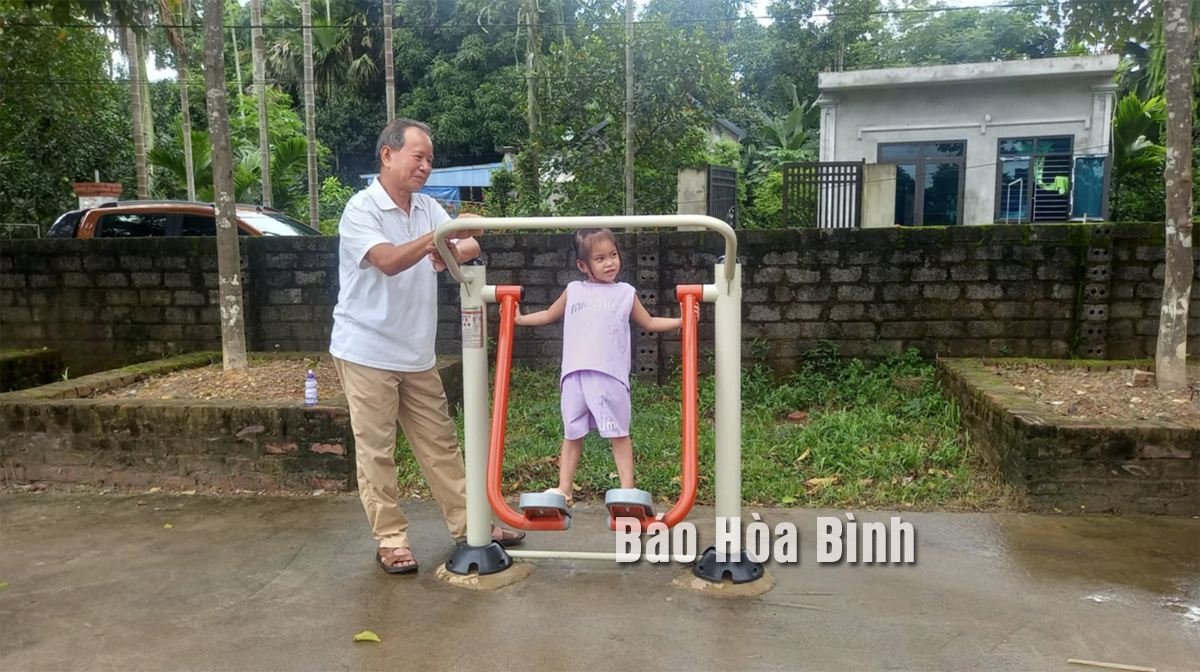
For the past few months, Bui Van Hoa from Binh Tan village, Nam Thuong commune, Kim Boi district, has been taking his granddaughter to the village cultural centre almost every day. According to him, the centre once deteriorated with no sports equipment available, and only the youth came there for football. With a local new-style rural development drive, families pooled their resources to purchase sports equipment and give it a facelift. Now, with a place to play and exercise in, children spend more time outdoors during summer and less time on their phones, he said.

Bui Van Hoa from Binh Tan village, Nam Thuong
commune, Kim Boi district, plays and exercises with his granddaughter at the
village cultural centre.
Bui Ngoc Tinh, Secretary of the village’s Party cell,
explained that public awareness about the benefits of building an advanced
new-style rural area has grown. They have realised that it means better
material and spiritual life for everyone, with the primary beneficiaries being
the residents themselves. As a result, families have voluntarily donated land
and funds to improve the village infrastructure. Roads have been upgraded, and
flower planting projects implemented to make the area more attractive.
Bui Van Toan, Vice Chairman of the Nam Thuong People's
Committee, revealed that the commune was selected for advanced new-style rural
building in Kim Boi. "This task is challenging, especially after the COVID-19
pandemic, which necessitated adjustments to some related policies. The process
is further complicated by cuts in public investment, making budget allocation
difficult. Although most officials, party members, and residents are committed
to the mission, there is still part of the population that relies heavily on
government support and has yet to fully embrace their role in the process,”
Toan explained. Challenges also include difficulties in securing investment
from financial institutions and insufficient local capital.
In response, the commune's Party Committee has tasked
various departments and organisations with mobilising and educating residents.
Between 2021 and 2025, Nam Thuong plans to invest over 117 billion VND (4.6
million USD) in advanced new-style rural development, with over 18 billion VND
or 15.3% of the total contributed by the residents.
Successful agricultural models have been implemented,
including the cultivation of pumpkin, other vegetables, and citrus fruits, as
well as livestock farming such as breeding cattle and free-range chickens. The
development of small industries and rural trades has also been encouraged. The
commune is promoting various rural services like transportation, land
preparation, milling, and retail sale, which contribute to job creation and
economic restructuring.
To date, the average per capita income has reached 60.58
million VND, and the multidimensional poverty rate is expected to drop to 7.89%
this year. The focus remains on enhancing value-added production and
sustainable development linked to new-style rural building.
Toan added that the commune is facing difficulties with environmental
criteria, such as waste management. However, those related to school
infrastructure and health insurance criteria have been basically addressed. Nam
Thuong is now awaiting relevant authorities to assess its compliance with the
advanced standard.
Hoa Binh province is undergoing a dynamic transformation amid Vietnam’s national digital transition. Building on Poliburo’s Resolution No. 57-NQ/TW on breakthroughs in science, technology, innovation, and national digital transformation, the province has rolled out a wide range of practical action plans. A standout initiative is the "Digital Literacy for All” movement, an effort to ensure that no one is left behind in the digital era.
Hoa Binh province is undergoing a dynamic transformation in the wake of the national digital transformation movement. Building on Resolution No. 57-NQ/TW of the Politburo on breakthroughs in science, technology, innovation, and national digital transformation, the province has implemented a wide range of practical action plans. A standout initiative is the "Digital Literacy for All” movement ambitious effort to ensure that no one is left behind in the digital age.
With a spirit of unity and proactive problem-solving, the Party Committee, the government and the people of Dong Lai Commune (Tan Lac District) have made great strides in implementing the resolutions of the 24th Party Congress of the commune for the 2020 - 2025 term. Focusing on leadership and practical actions, the commune has brought the Party’s resolutions into daily life, creating strong impacts and pushing the local development forward.
Amid the nationwide push for digital transformation, young people in Hoa Binh Province are stepping up as dynamic pioneers, applying technology to enhance Youth Union operations and expand the reach of youth-led initiatives. Through creativity and adaptability, Youth Union organizations at all levels have introduced a series of practical solutions, contributing to modern governance and community development.
In recent years, An Nghia commune, located in Lac Son district, has stepped up administrative reform, focusing on improving the quality and efficiency of its single-window service unit for receiving and processing administrative procedures. These improvements have helped create favourable conditions for local residents and organisations to handle administrative procedures, contributing to the commune’s broader socio-economic development.
The Prime Minister-approved master plan to develop the multi-use value of forests ecosystems through 2030, with a vision to 2050, aims to improve the management and sustainable use of forest resources, create jobs, increase incomes, and improve the living standards of ethnic minorities, people in mountainous and remote areas, forest workers and those living near forests.



